汉服中英文翻译简介
- 格式:doc
- 大小:38.50 KB
- 文档页数:2
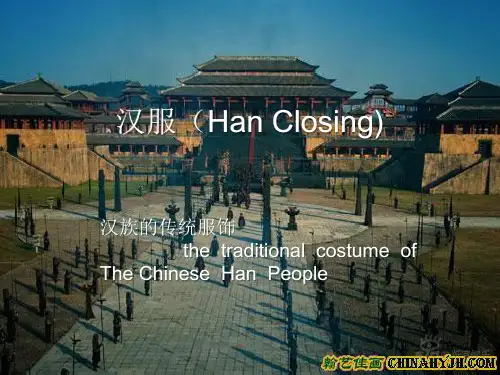
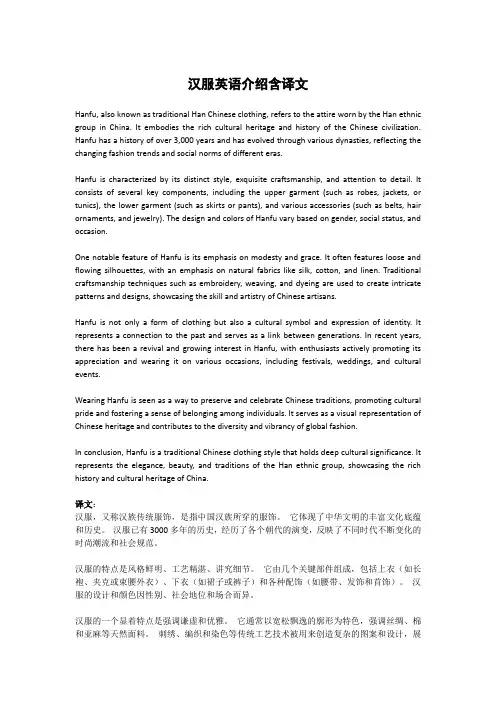
汉服英语介绍含译文Hanfu, also known as traditional Han Chinese clothing, refers to the attire worn by the Han ethnic group in China. It embodies the rich cultural heritage and history of the Chinese civilization. Hanfu has a history of over 3,000 years and has evolved through various dynasties, reflecting the changing fashion trends and social norms of different eras.Hanfu is characterized by its distinct style, exquisite craftsmanship, and attention to detail. It consists of several key components, including the upper garment (such as robes, jackets, or tunics), the lower garment (such as skirts or pants), and various accessories (such as belts, hair ornaments, and jewelry). The design and colors of Hanfu vary based on gender, social status, and occasion.One notable feature of Hanfu is its emphasis on modesty and grace. It often features loose and flowing silhouettes, with an emphasis on natural fabrics like silk, cotton, and linen. Traditional craftsmanship techniques such as embroidery, weaving, and dyeing are used to create intricate patterns and designs, showcasing the skill and artistry of Chinese artisans.Hanfu is not only a form of clothing but also a cultural symbol and expression of identity. It represents a connection to the past and serves as a link between generations. In recent years, there has been a revival and growing interest in Hanfu, with enthusiasts actively promoting its appreciation and wearing it on various occasions, including festivals, weddings, and cultural events.Wearing Hanfu is seen as a way to preserve and celebrate Chinese traditions, promoting cultural pride and fostering a sense of belonging among individuals. It serves as a visual representation of Chinese heritage and contributes to the diversity and vibrancy of global fashion.In conclusion, Hanfu is a traditional Chinese clothing style that holds deep cultural significance. It represents the elegance, beauty, and traditions of the Han ethnic group, showcasing the rich history and cultural heritage of China.译文:汉服,又称汉族传统服饰,是指中国汉族所穿的服饰。
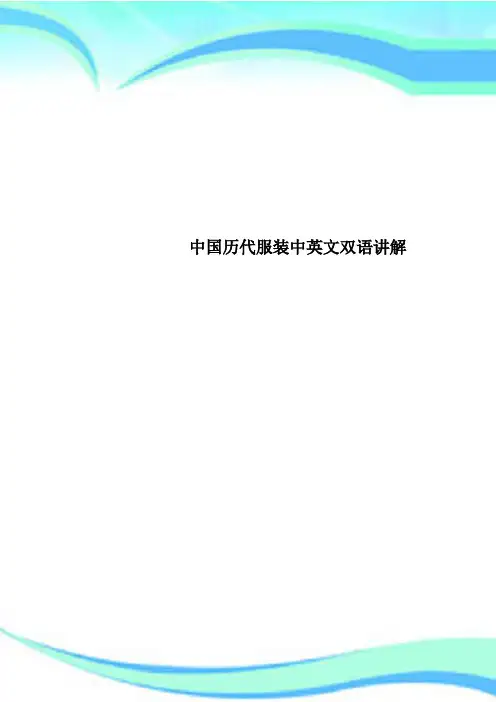
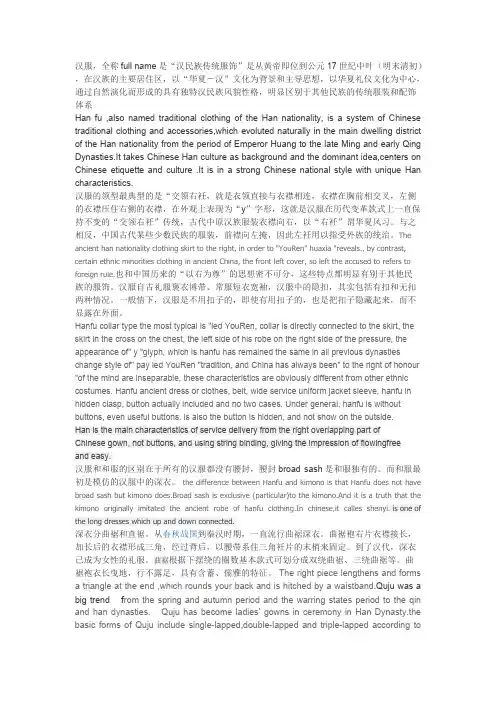
汉服,全称full name是“汉民族传统服饰”是从黄帝即位到公元17世纪中叶(明末清初),在汉族的主要居住区,以“华夏-汉”文化为背景和主导思想,以华夏礼仪文化为中心,通过自然演化而形成的具有独特汉民族风貌性格,明显区别于其他民族的传统服装和配饰体系Han fu ,also named traditional clothing of the Han nationality, is a system of Chinese traditional clothing and accessories,which evoluted naturally in the main dwelling district of the Han nationality from the period of Emperor Huang to the late Ming and early Qing Dynasties.It takes Chinese Han culture as background and the dominant idea,centers on Chinese etiquette and culture .It is in a strong Chinese national style with unique Han characteristics.汉服的领型最典型的是“交领右衽,就是衣领直接与衣襟相连,衣襟在胸前相交叉,左侧的衣襟压住右侧的衣襟,在外观上表现为“y”字形,这就是汉服在历代变革款式上一直保持不变的“交领右衽”传统,古代中原汉族服装衣襟向右,以“右衽”谓华夏风习。
与之相反,中国古代某些少数民族的服装,前襟向左掩,因此左衽用以指受外族的统治。
The ancient han nationality clothing skirt to the right, in order to "YouRen" huaxia "reveals., by contrast, certain ethnic minorities clothing in ancient China, the front left cover, so left the accused to refers to foreign rule.也和中国历来的“以右为尊”的思想密不可分,这些特点都明显有别于其他民族的服饰。
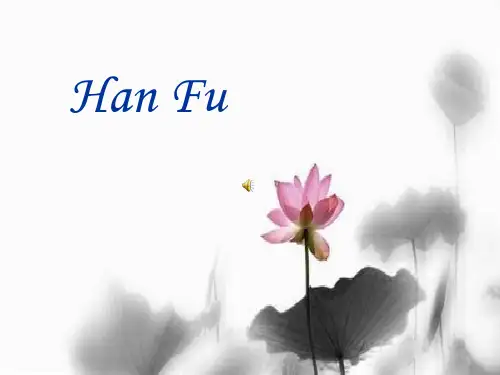

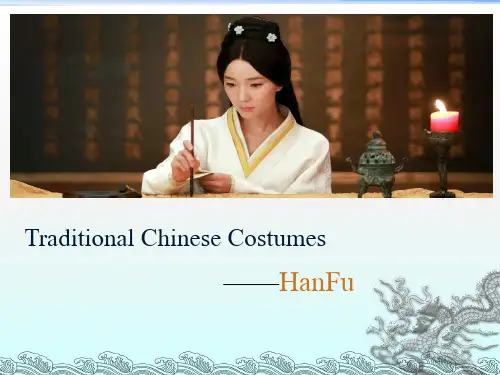
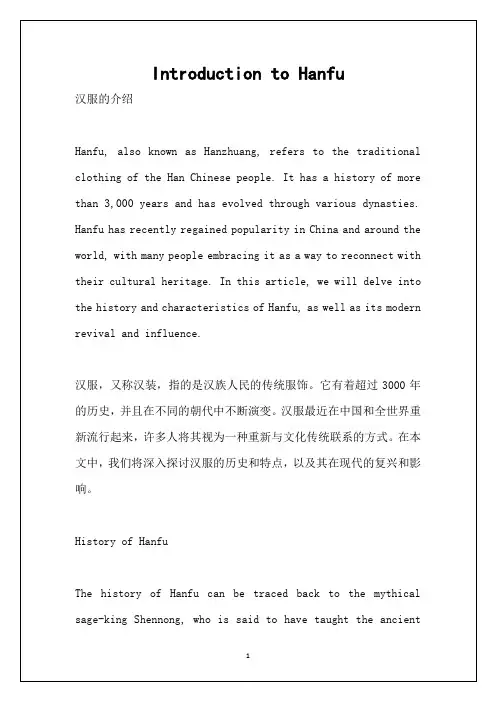
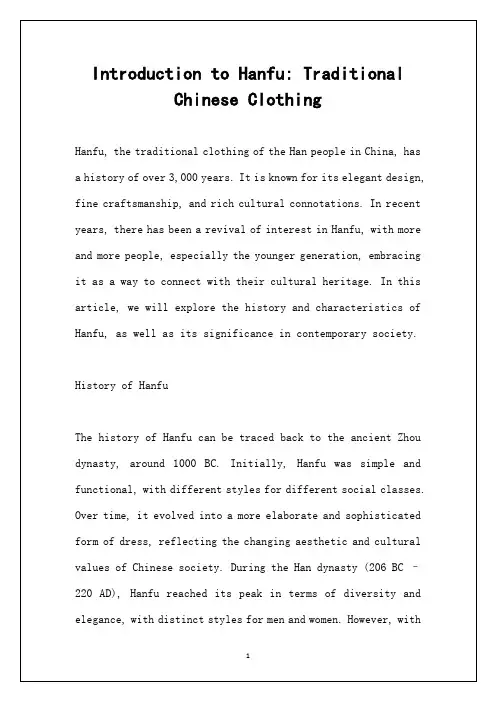
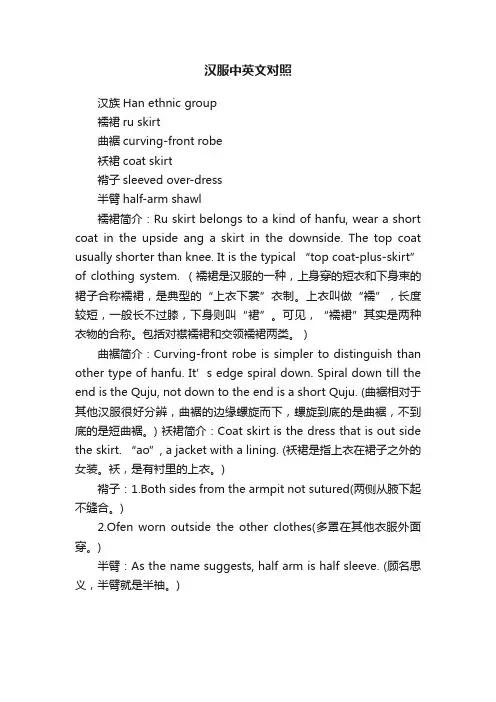
汉服中英文对照汉族Han ethnic group襦裙ru skirt曲裾curving-front robe袄裙coat skirt褙子sleeved over-dress半臂half-arm shawl襦裙简介:Ru skirt belongs to a kind of hanfu, wear a short coat in the upside ang a skirt in the downside. The top coat usually shorter than knee. It is the typical “top coat-plus-skirt” of clothing system. (襦裙是汉服的一种,上身穿的短衣和下身束的裙子合称襦裙,是典型的“上衣下裳”衣制。
上衣叫做“襦”,长度较短,一般长不过膝,下身则叫“裙”。
可见,“襦裙”其实是两种衣物的合称。
包括对襟襦裙和交领襦裙两类。
)曲裾简介:Curving-front robe is simpler to distinguish than other type of hanfu. It’s edge spiral down. Spiral down till the end is the Quju, not down to the end is a short Quju. (曲裾相对于其他汉服很好分辨,曲裾的边缘螺旋而下,螺旋到底的是曲裾,不到底的是短曲裾。
) 袄裙简介:Coat skirt is the dress that is out side the skirt. “ao”, a jacket with a lining. (袄裙是指上衣在裙子之外的女装。
袄,是有衬里的上衣。
)褙子:1.Both sides from the armpit not sutured(两侧从腋下起不缝合。
)2.Ofen worn outside the other clothes(多罩在其他衣服外面穿。
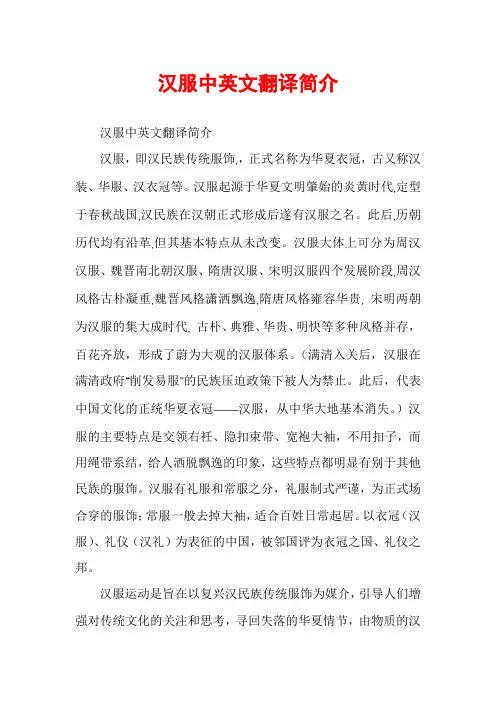
汉服中英文翻译简介汉服中英文翻译简介汉服,即汉民族传统服饰,,正式名称为华夏衣冠,古又称汉装、华服、汉衣冠等。
汉服起源于华夏文明肇始的炎黄时代,定型于春秋战国,汉民族在汉朝正式形成后遂有汉服之名。
此后,历朝历代均有沿革,但其基本特点从未改变。
汉服大体上可分为周汉汉服、魏晋南北朝汉服、隋唐汉服、宋明汉服四个发展阶段,周汉风格古朴凝重,魏晋风格潇洒飘逸,隋唐风格雍容华贵, 宋明两朝为汉服的集大成时代, 古朴、典雅、华贵、明快等多种风格并存,百花齐放,形成了蔚为大观的汉服体系。
(满清入关后,汉服在满清政府“削发易服”的民族压迫政策下被人为禁止。
此后,代表中国文化的正统华夏衣冠――汉服,从中华大地基本消失。
)汉服的主要特点是交领右衽、隐扣束带、宽袍大袖,不用扣子,而用绳带系结,给人洒脱飘逸的印象,这些特点都明显有别于其他民族的服饰。
汉服有礼服和常服之分,礼服制式严谨,为正式场合穿的服饰;常服一般去掉大袖,适合百姓日常起居。
以衣冠(汉服)、礼仪(汉礼)为表征的中国,被邻国评为衣冠之国、礼仪之邦。
汉服运动是旨在以复兴汉民族传统服饰为媒介,引导人们增强对传统文化的关注和思考,寻回失落的华夏情节,由物质的汉服导向精神的文明,并最终实现传统中华文化向现代转型的社会文化复兴运动。
“中国有服章之美谓之华,有礼仪之大谓之夏”,与华夏衣冠(汉服)相应的礼不是形式,而是民族历史之积淀,民族之根脉,汉服之美更须礼仪之大的依托。
礼的卑己尊人、长幼有序、严密规范诠释着华夏社会的理想,而庄重、纯正、质朴的周礼更充分的发挥了礼的内涵。
汉服属广义的礼的范畴,通过礼仪的形式,指向华夏文明的内涵,因此汉服是礼与仁的统一。
Han served, that is, the traditional costume of the Han nationality, formally known as the Chinese dressed, also known as the ancient Chinese equipment, and services to China and Chinese dressed, and so on.第一张图。
介绍汉服的英语作文_Introduce Hanfu 4篇导读:关于”介绍汉服“的英语作文模板4篇,作文题目:Introduce Hanfu。
以下是关于介绍汉服的小学英语模板,每篇作文均为万能模板带翻译。
关于”介绍汉服“的英语作文模板4篇,作文题目:Introduce Hanfu。
以下是关于介绍汉服的小学英语模板,每篇作文均为万能模板带翻译。
高分英语作文1:Introduce HanfuXuanduan is a dress made to order in Zhou Dynasty. It is dark black and has wide sleeves. It is only used in large-scale activities, such as sacrificial opera Costume: one piece fashion dress with one or several rings around the body, forming a unique style.During the Warring States period, it was cost-effective as a market dress, while in the Han Dynasty, it was regarded as a formal dress. Because some of its narrow lapels did not spread to later generations, it was often mistaken for the kimono Shenyi (long skirt): in the Warring States period, the clothing was worn by both men and women (different from the popular upper and lower garments, which were composed of cloth pieces), which symbolized that there were several months in a year, and there was no fashion at that time It was passed down, but it was made into men's formal straight dress (straight dress) in the Ming Dynasty: through cutting men's clothes, fastening them with a belt or corset collar, and using a piece of cloth to form a lower garment, in the Ming Dynasty, it was usually made into a men's dress of togaz clergy,which was cut and made into a style of pendulum skirt with dark knees: Women's dress, such as a Katy Sark, while a group was a skirt Half sleeve women's upper garment, with sleeves similar to the current short sleeve open-ended skirt of Tang Dynasty style, similar to the general Ruqun, but tied on the chest, with Kezi and Chinese style jacket, Hanfefers to its style, front open collar jacket: Women's jacket of Tang Dynasty, not the common cross collar of Han Dynasty, but the open-ended horse face group not popular after the Tang Dynasty: a skirt of Ming Dynasty, with It has a rather gorgeous pendulum style: a cloak, as men's and women's clothes, Duanda (short clothes): the casual clothes of the working people, Chinese jacket and trousers, the jacket has a slit on both sides, and the sleeves are narrow, which is very convenient for labor. It can be used as casual clothes and household underwear: men wear underpants and pants, women wear underpants, and men must wear Zhongdan, and wear a white robe on their underwear.When people wear clothes, Han clothes without underwear are considered impolite, just as people wear suits without shirts.中文翻译:玄端为周代定做的礼服深黑色,袖子很宽,只在大型活动中使用,如祭品曲剧服:一件式的时装,在身体周围戴一个或几个环子,形成独特的风格。
汉服介绍英文作文素材英文,Introduction to Hanfu。
Hanfu is the traditional clothing of the Han Chinese people, which has a history of over 3,000 years. It is characterized by its unique style, exquisite craftsmanship, and rich cultural connotations. Hanfu has different styles for different occasions, such as daily wear, formal wear, and ceremonial wear.中文,汉服介绍。
汉服是汉族人民的传统服饰,历史悠久,有超过三千年的历史。
它以其独特的风格、精湛的工艺和丰富的文化内涵而著称。
汉服有不同的款式适用于不同的场合,如日常穿着、正式场合和仪式场合。
英文,Styles of Hanfu。
There are many styles of Hanfu, each with its ownunique characteristics. For example, the Ruqun styleconsists of a blouse and a long skirt, and is suitable for daily wear. The Zhiduo style, which has a long gown with wide sleeves and a skirt, is more formal and is often worn for important occasions such as weddings. The Shenyi style, which has a cross-collar and a long gown, is often used for ceremonial occasions.中文,汉服的款式。
有关汉服英语作文带翻译Title: The Cultural Significance of Hanfu。
Hanfu, traditional Chinese clothing, embodies a rich cultural heritage that spans millennia. Its significance transcends mere fashion, reflecting the values, aesthetics, and historical identity of the Chinese people. In this essay, we will delve into the profound cultural meanings behind Hanfu.Firstly, Hanfu serves as a tangible link to China's ancient past. With origins dating back over 3,000 years, Hanfu represents a continuity of tradition and heritage.Its design, characterized by loose, flowing robes and intricate patterns, harks back to the attire worn by theHan ethnic group during the Han Dynasty and earlier periods. By wearing Hanfu, individuals not only pay homage to their ancestors but also connect with the enduring spirit of Chinese civilization.Moreover, Hanfu embodies Confucian ideals of propriety and respect for tradition. In Confucian philosophy,clothing is viewed as a reflection of one's moral character and social status. Hanfu, with its modest yet elegant style, exemplifies these principles. Its emphasis on modesty and restraint aligns with Confucian values of humility andself-discipline. By adhering to traditional dress codes, individuals demonstrate their adherence to Confucian ethics and contribute to the preservation of cultural norms.Furthermore, Hanfu serves as a symbol of cultural pride and identity. In recent years, there has been a resurgenceof interest in Hanfu among Chinese youth, driven by adesire to reclaim and celebrate their cultural heritage. By donning Hanfu attire, individuals express a sense of pridein their Chinese identity and assert their distinctivenessin an increasingly globalized world. Hanfu enthusiasts participate in various cultural events and gatherings, fostering a sense of community and solidarity among like-minded individuals.Additionally, Hanfu reflects the aestheticsensibilities of traditional Chinese art and literature. Inspired by nature and classical motifs, Hanfu designs incorporate elements such as floral patterns, auspicious symbols, and poetic imagery. The use of luxurious fabrics such as silk and brocade further enhances its visual appeal. Through its graceful lines and harmonious proportions,Hanfu embodies the timeless beauty and elegance admired in traditional Chinese aesthetics.In conclusion, Hanfu represents more than just a formof clothing; it embodies the cultural heritage, values, and identity of the Chinese people. As a symbol of tradition, propriety, and pride, Hanfu continues to resonate with individuals seeking to connect with their roots andpreserve their cultural legacy. By embracing Hanfu, wehonor the past, celebrate the present, and inspire future generations to cherish and uphold our shared cultural heritage.汉服,传统的中国服饰,体现了跨越数千年的丰富文化遗产。
有关汉服介绍翻译英语作文Title: Introduction to Hanfu: Exploring the Essence of Traditional Chinese Attire。
Introduction。
Hanfu, as the traditional attire of the Han Chinese people, embodies a rich cultural heritage that dates back thousands of years. Rooted deeply in Chinese history and aesthetics, Hanfu represents not just a style of clothing but also a way of life and a reflection of philosophical and social values. In this essay, we will delve into the essence of Hanfu, exploring its history, significance, and contemporary revival.Historical Origins。
The origins of Hanfu can be traced back to the Xia, Shang, and Zhou dynasties (c. 21st century BCE–256 BCE), where garments were characterized by loose, flowing designswith draped sleeves and wide skirts. During the Han dynasty (206 BCE–220 CE), Hanfu evolved into a more structured and refined form, with distinct styles for different social classes and occasions. This period marked the zenith of Han Chinese culture, and Hanfu became synonymous with elegance and sophistication.Significance and Symbolism。
什么是汉服英语介绍作文"Hanfu: A Brief Introduction in English"Hanfu, the traditional attire of the Han Chinese people, embodies centuries of cultural heritage and artistic expression. Rooted in ancient customs and traditions, Hanfu serves not only as clothing but also as a symbol ofidentity and pride for many Chinese individuals today. In this essay, we will delve into the rich history and significance of Hanfu, exploring its evolution, styles, and cultural impact.The term "Hanfu" literally translates to "Han clothing," referring to the attire worn by the Han ethnic group, the largest ethnic group in China. Hanfu has ahistory spanning thousands of years, with its originsdating back to the early periods of Chinese civilization.It evolved over time, influenced by various dynasties,social norms, and cultural exchanges, resulting in adiverse array of styles and designs.One of the distinguishing features of Hanfu is its emphasis on modesty, elegance, and harmony with nature. Traditional Hanfu garments typically consist of several layers, including a robe-like garment known as the "yi," a long skirt or trousers called the "chang," and various accessories such as sashes, belts, and hair ornaments. The choice of fabric, color, and embroidery often reflects the wearer's social status, occasion, and personal taste.Hanfu styles vary across different dynasties and regions, each reflecting the unique cultural and aesthetic preferences of the time. For example, during the Han Dynasty (206 BCE – 220 CE), Hanfu was characterized by loose-fitting robes with wide sleeves and elaborate headdresses. In contrast, the Tang Dynasty (618 – 907 CE) saw the emergence of more form-fitting garments with intricate patterns and vibrant colors.Despite its rich history, Hanfu experienced a decline in popularity during the Qing Dynasty (1644 – 1912), when Manchu-style clothing became the dominant fashion underQing rule. However, in recent years, there has been a resurgence of interest in Hanfu, fueled by a growing senseof cultural pride and nostalgia among young Chinese people.Today, Hanfu enthusiasts can be found across China and around the world, participating in various cultural events, festivals, and social gatherings. Online communities dedicated to Hanfu culture have also flourished, providing platforms for enthusiasts to share their passion for traditional attire, exchange fashion tips, and showcasetheir own Hanfu creations.Beyond its aesthetic appeal, Hanfu holds profound cultural significance for many Chinese individuals. For them, wearing Hanfu is not merely a fashion statement but a way of connecting with their cultural heritage and preserving traditions passed down through generations. By reviving and promoting Hanfu culture, they hope to foster a greater appreciation for China's rich history and promote cross-cultural understanding.In conclusion, Hanfu represents more than just clothing;it is a tangible expression of China's cultural identity and historical legacy. Through its intricate designs, vibrant colors, and timeless elegance, Hanfu continues to captivate the hearts and minds of people around the world, serving as a testament to the enduring beauty and resilience of Chinese culture.。
Traditional Costume of Han NationalityWhen I wanted to introduce the Han nationality; When intended to give publicity for the Han nationality; When I saw the 56 ethnic groups take photos together, I always thought about what is our national costume?What is the traditional costume of the Han nationality? Is that Cheongsam? Tang suit? Or just reluctantly say that,” sorry, we don’t have traditional costume”? Of course no!Our name is Han. Our language is Chinese. Our word is the Chinese characters. And then, if there is a kind of clothing that only belongs to the Han nationality, it must be Hanfu, without a doubt!Hanfu exist in Han culture and Han people’s life for more t han 3000 years until the ruler of Qing-dynasty forced Han people to give up there traditional costume.In ancient China, both men and women only wore clothes that overlap the right side to the left side. The opposite right-over-left style is for other nations. For Han people, right-over-left style meantdeath.There are many kind of Hanfu, like Shenyi, which could wear on Chinese holiday or some important ceremonies. The Zhiduo was worn by men. It was popular among scholar in Ming Dynasty. In addition, the Ruqun, Zhaoshan, Duanda are general style of Hanfu.Nowadays, most people know about Japanese Kimono and Korean Hanbok, but few of them know that they were both created based on the styles of Hanfu. What a big irony!。
汉服,即汉民族传统服饰,,正式名称为华夏衣冠,古又称汉装、华服、汉衣冠等。
汉服起源于华夏文明肇始的炎黄时代,定型于春秋战国,汉民族在汉朝正式形成后遂有汉服之名。
此后,历朝历代均有沿革,但其基本特点从未改变。
汉服大体上可分为周汉汉服、魏晋南北朝汉服、隋唐汉服、宋明汉服四个发展阶段,周汉风格古朴凝重,魏晋风格潇洒飘逸,隋唐风格雍容华贵, 宋明两朝为汉服的集大成时代, 古朴、典雅、华贵、明快等多种风格并存,百花齐放,形成了蔚为大观的汉服体系。
(满清入关后,汉服在满清政府“削发易服”的民族压迫政策下被人为禁止。
此后,代表中国文化的正统华夏衣冠——汉服,从中华大地基本消失。
)汉服的主要特点是交领右衽、隐扣束带、宽袍大袖,不用扣子,而用绳带系结,给人洒脱飘逸的印象,这些特点都明显有别于其他民族的服饰。
汉服有礼服和常服之分,礼服制式严谨,为正式场合穿的服饰;常服一般去掉大袖,适合百姓日常起居。
以衣冠(汉服)、礼仪(汉礼)为表征的中国,被邻国评为衣冠之国、礼仪之邦。
汉服运动是旨在以复兴汉民族传统服饰为媒介,引导人们增强对传统文化的关注和思考,寻回失落的华夏情节,由物质的汉服导向精神的文明,并最终实现传统中华文化向现代转型的社会文化复兴运动。
“中国有服章之美谓之华,有礼仪之大谓之夏”,与华夏衣冠(汉服)相应的礼不是形式,而是民族历史之积淀,民族之根脉,汉服之美更须礼仪之大的依托。
礼的卑己尊人、长幼有序、严密规范诠释着华夏社会的理想,而庄重、纯正、质朴的周礼更充分的发挥了礼的内涵。
汉服属广义的礼的范畴,通过礼仪的形式,指向华夏文明的内涵,因此汉服是礼与仁的统一。
Han served, that is, the traditional costume of the Han nationality, formally known as the Chinese dressed, also known as the ancient Chinese equipment, and services to China and Chinese dressed, and so on.第一张图。
Hanfu served in the origin of Chinese civilization Yanhuang beginning of the era, in the shape of the Spring and Autumn, an official of the Han nationality in the Han Dynasty was formed there in the name of serving the Han. Since then, the historical evolution of all ages, but never changed its basic characteristics.第二张Han served on the whole service can be divided into the Han Zhou, Wei and Jin Han clothing, Sui, Tang and Han clothing, Han clthing served four stages of development, 第三张Zhou style dignified simplicity, elegant chic style of the Wei, Jin, Sui and Tang dynasties Yongronghuagui style, Song and Ming Dynasties Han served as the master of the times, simple, elegant, crisp style and other co-exist, letting a hundred flowers bloom, the formation of the Han Weiweidaguan service system.
The main features of Chinese clothing is to pay the right collar overlapping part of Chinese gown, the band deducted hidden, Kuanpao big sleeves, no buttons, and use string binding, giving the impression of free and easy flowing, the characteristics of these obviously are different from those of other ethnic costumes. 第五张Han and dressed in uniforms or dress suits are divided, strict standard dress for formal occasions, wear costumes; general dressed in uniforms or remove large sleeves for the common people daily. Dressed to (Chinese service), courtesy (Han-li) for the characterization of China, was dressed as the neighboring country, Liyizhibang. 第六张
Han is a service campaign aimed at revitalization of the traditional costumes of the Han nationality for the media to lead people to strengthen the traditional culture of the concerns and thinking, the Chinese recovered the lost plot by the Chinese
service-oriented material and spiritual civilization, and ultimately to the traditional Chinese culture The transformation of modern social and cultural renaissance movement. 第七张
"China has a service called Chapter of the United States and China, that great ritual of summer", and dressed Chinese (Chinese services) is not in the form of the ceremony, but the nation's history and heritage, the roots of the nation, the Chinese service of the United States to be more ceremonial Relying on the large. The British ceremony has been respected, young and old, orderly and strict interpretation of the norms of Chinese society ideals, and the solemn, pure and simple Zhou's better to play the ceremony content. 第八张
Han served a broad scope of the ceremony, the rite of passage in the form of point to the connotation of Chinese civilization, it is serving the Han and Hui, the unity ceremony. 第九张。